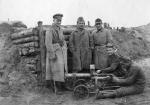-
Posts
2,962 -
Joined
-
Last visited
Content Type
Profiles
Forums
Blogs
Gallery
Events
Store
Everything posted by Chip
-

Baden Shoulder Board
Chip replied to Rod's topic in Germany: Imperial Uniforms, Headwear, Insignia & Personal Equipment
Well, as to the style, you are very close. The 66th would look just like this with a red underlay and of course, the correct numbers and the your additional pip. There is no source you can go to in order to get the board you are looking for. Shoulder boards can be illusive, especially when you are looking for a specific unit and a specific rank. Just keep looking (especially on German eBay or Weitze's website) and you might get lucky. Chip -
Chris, Red thread is good! The original backing would have been red and most likely the thread too. The length of these boards, or any other pattern for that matter, has nothing to do with what goes on them. I could show you lots of officer's boards that are nearly completely full with insignia from top to bottom. And then, on the other hand, huge boards with nothing. This was just the style of the time. All higher grade officer's boards would have looked something like this in the 1880's and 1890s. Though officer's could do about anything they wanted, within reason, the general guidelines were normally adhered to. Length could be whatever suited the soldier and the tailor. There was more latitude with length as opposed to width. I don't collect these older pattern boards, so I would not venture to say what they are worth. Besides, these days, as I am sure you have noticed on eBay, who knows what anything is worth. The world has gone mad. I'm repeatedly stunned by the prices that things sell for. My ideas of value are from a bygone era when one sat at home and wrote letters and things had a more stable value. But since you asked, I would say that I would buy them for $160, but 160 Euro is about $210.00. Perhaps if I was more interested in the era..... Chip
-
Chris, I don't think that such boards were made without some sort of backing, whose main purpose is to give some foundation to the loops which are more or less tacked together. The reason you do not see the backing in so many photos is that, particularly, on this pattern of officer's cords, the backing was very small and came nowhere near the edge of the board. I submit to you another high officer board of the same style with the type of backing that I am referring to. As you can see, this type of backing would never have been seen from the top. Perhaps, in your case, (and given the holes in the retaining straps, the backing was so badly eaten, as to have been removed. Your retaining straps do look somewhat resewn. I have lightened up the piece somewhat as it is black and hard to see, but I think you will see what I am alluding to. This board is 15cm long and only has an ?skulapstab and one pip. Chip
-
Chris, I can narrow it down a bit by telling you that the regimental cypher was not introduced until November 5, 1913. It does seem a bit odd to see this cypher on an old style board. Perhaps the lack of backing material is telling us something about the originality of this crown and cypher being on these boards? Chip
















